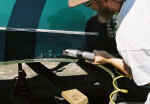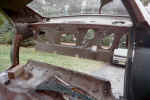After opening up the places where rust was obvious, the clear first step was to locate a replacement trunk floor and wheel wells. Unlike Chevelles, many parts are not available for 69 Impalas including wheel wells, trunk braces and trunk extensions. I located a replacement trunk at Hidden Valley Auto Parts and had it shipped. This included the entire bottom third of the car. This was a full width section including wheel wells, trunk floor and braces back to the trunk lip at the back.
The In addition to the trunk replacement, the general approach is to cut out any remaining rusted areas and weld new metal in place. When this was not possible (parts of the rocker panel and inside the lower cowl areas), I cleaned it up as well as possible, used Rass-O'-Nil rust converter and painted with either epoxy paint or Zero-Rust.


